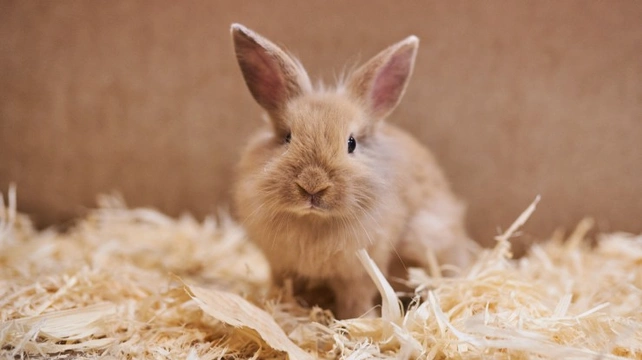
The problems with ‘sticky bums’ on rabbits
Sticky bums are not a joke, they are a reality in rabbits, and potentially can cause quite serious problems in your pet bunnies’ health.
The first thing to ensure is that your rabbit has a healthy diet, so that it produces acceptable ‘stools’ or ‘poo’, which can take two different forms.
All rabbits have a delicate stomach or gut and certain foods can cause digestive problems, resulting in some potentially serious health issues. Diets that are high in carbohydrates or have too much sugar or starch will not be good for your rabbit.
There are two acceptable types of faeces which are either round and large (due to good fibre levels) and should be dry, or another, known as caecal pellets which are generally eaten by the rabbit themselves, but if not, they can stick to the area around the back passage – hence the name ‘sticky bottoms’. If these remain, it can cause some serious health problems. Diets such as those described above (sugar laden or carb laden) will to cause faeces to stick to their fur and put your rabbit at risk of health problems. This really is not what you want.
Contrary to popular and much ‘cartoonised’ views, rabbits for instance should not be overdosed on carrots – they contain a lot of sugar, as do some other vegetables and fruit. A tiny cube of carrot is more than enough for a rabbit’s treat. Always check with the breeder you bought your pet from, or with your vet, in order to attain a good, balanced diet for your rabbit – it’s worth the effort.
Reasons why your rabbit can’t or won’t eat their caecal pellets
There are many reasons why your pet rabbits have a problem with this. If your pet has issues with other health problems, this can prevent them from carrying out their own cleaning duties:
Injury or Mobility Issues
Injuries to your rabbit’s back or hind legs rendering them immobile to a certain extent, will prevent them from getting to the relevant area to clean off the faeces, in fact, a virtual impossibility. Equally so, rabbits are not exempt from getting arthritis, which also makes it difficult for them to reach the necessary areas to remove faeces. You will know if and when your rabbit shows signs of arthritis – it may rub its bottom across the floor, and then run around trying to eat up any faeces he has managed to remove. Otherwise, you may never know, as rabbits tend not to show any pain, they are brave little souls.
Overweight or obese rabbits
No different to this human complaint, things become a lot more difficult to reach areas that need to be kept clean. It also puts a massive strain on the skeletal structure and important organs – interestingly, it is probably the main cause of ‘sticky bottoms’. Weight loss is imperative if this happens to your bunny, and more foodstuffs such as grass, hay and a slightly increased amount of green leafy vegetables, should make it easier and in fact tastier to give them the desire to eat their faeces.
Infections
If the area around the anus is covered in old faeces and not regularly cleaned, your rabbit is in danger of skin infections and hair loss and this will cause them pain. Keeping the area clean is vital, whilst you continue to improve their overall health issues, whether it is obesity or immobility. Cleaning should be isolated to the area that needs it, a wash and thorough dry should do the trick daily. Try hard not to leave the fur damp around the area as this can cause more irritation of the original problem_._ If infection persists, do consult your vet who may wish to prescribe antibiotics or barrier cream if infection is not present, just to calm the area down. This problem still needs to be treated with a matter of urgency before they worsen.
Flystrike – a rabbit’s worst nightmare
This probably qualifies as one of the most horrible things that your rabbit can develop. It is caused by the strain of bluebottles and greenbottles that pick up various bacteria in their own hunt for food – frequently they ‘dine out’ on carcasses and rotting food that contain a wealth of ‘nasties’ as you can imagine. These species of fly will lay their eggs on fur that is damp or wounded in some way and is particularly prevalent in hot and humid weather. Maggots will develop very quickly (within 12-24 hours) and soon they will munch their way through live flesh on your rabbit at a fast rate of knots.
You should check your rabbit’s fur at least once a day in standard weather and at least two or three times during unusually warm and humid conditions. Keeping the area clean is vital at these times, as the larvae will bury right into the skin and be very difficult to see in the very early stages.
Excess urine or faeces will attract any of the flies that are around in the summer months, but it can happen at any time of the year. If your rabbit has any of the problems associated with them having sticky bottoms, you must make every effort to keep the area clean so as not to attract this horrible species You also need to keep their hutches, bedding any outdoor area as clean as possible.
Should your rabbit have the misfortune of getting flystrike, immediate or should we say, urgent attention is needed by your vet. Delay in treating this condition can endanger your rabbit’s life very, very quickly.
If you keep your rabbit healthy, at a sensible weight, and watch for other symptoms of sticky bottoms and keep the anal area clean, you should be a happy bunny owner.



